The Buddha at the Bellagio: (Teaching) Religion in Sin City
The abundance of religion in Las Vegas, from wedding chapels to nightclubs, reveals much about religious life in the 21st century
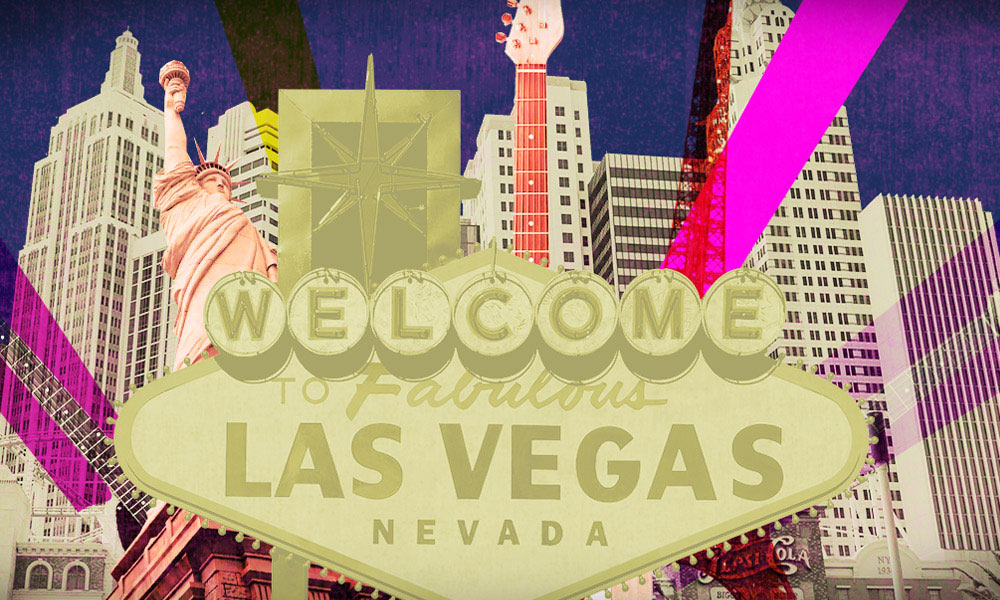
(Image source: uDiscoverMusic)
Las Vegas is measured out in neon signs and billboards. The public charter school where I teach English and Comparative Religions is eight miles from the iconic Welcome to Fabulous Las Vegas sign. It is three miles from “Vegas Vic,” the folksy neon cowboy on Fremont street. It is four miles from the Little Darlings strip club and its billion-bulb billboard, which in June of every year advertises employment opportunities to my graduating high school seniors: “Now hiring class of 20XX!”
But the most interesting billboard, to me, is the one for Tao Nightclub. A large image of the Buddha appears alongside the mysterious tagline, “Religious Nightlife.” A similar billboard for the same nightclub promises “Spiritual Dining,” whatever that is, and rather presumptuously states that “Your Prayers Have Been Answered.”
The Tao billboard is only one example of the ubiquity of religion on the Strip. The Bellagio Hotel and Casino features a golden Buddha statue. This Buddha is only one of many on the Strip, joining a sangha of Buddhas at Mandalay Bay and the Aria.
What would the Buddha think about his image being used to decorate these Temples of Tanha (sanskrit: “craving, thirst, longing, grasping, greed”)? Sidhartha Gautama, a prince who became the Buddha, rejected the lavish luxuries of his palatial childhood home; his great contribution to religious thought was that life’s suffering derives from our cravings. Extinguish these cravings, he realized, and suffering is also extinguished. That the Buddha should preside over clinking slot machines and bottomless mimosas and all-you-can-eat buffets is rich irony indeed. A widely published promo for Tao Nightclub celebrates indulgence of any craving, mood, or desire:
“Upon entry, guests are transported from the City of Sin to the Pacific Rim with Tao’s lush velvets and silks, waterfalls and century-old woods and stones. An extensive collection of Buddha statues watches over every corner of Tao, including a unique reclining Buddha and Tao’s signature 20-foot Buddha that “floats” peacefully above an infinity pool complete with Japanese koi. The nightclub is accented by a moat bar, adorned with breathtaking red chandeliers and a Monk Bar decorated with a wall of almost 300 hand carved monks and candles and nightlife reigns supreme at Tao with enticing options to indulge any mood.”
What purpose do these statues of the Buddha serve? Does the Buddha’s presence somehow sanction the activities in the nightclub and quiet the consciences of patrons? Does he give indulgence a patina of spirituality, of exotic culture, of cosmopolitan sophistication?
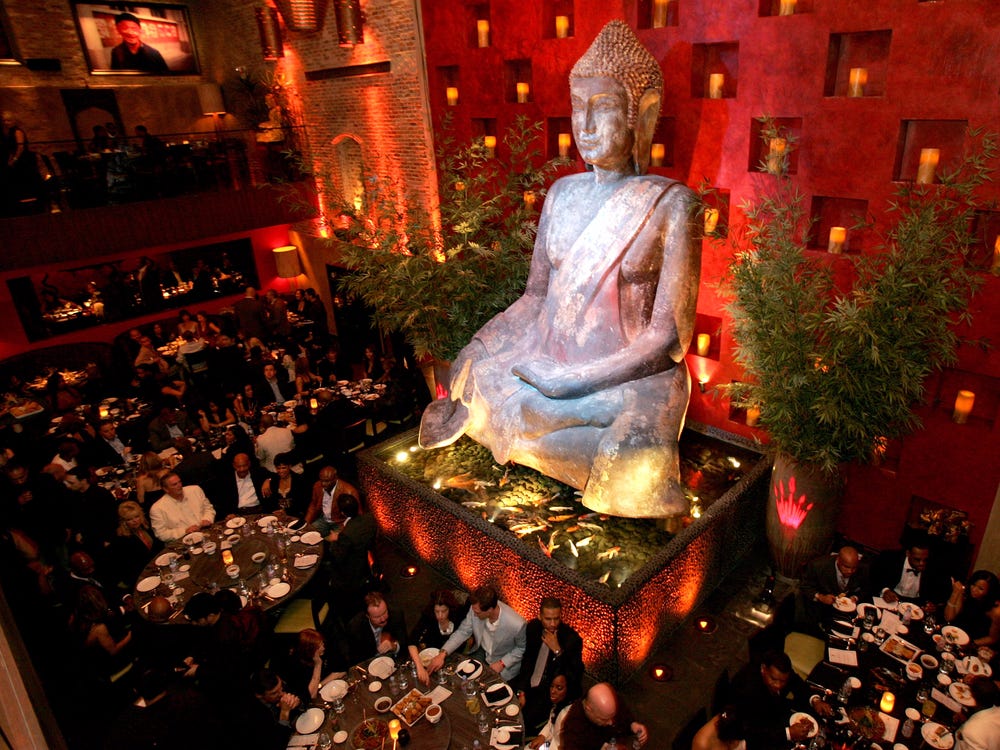
(Tao restaurant and nightclub. Image source: Getty Images)
While it is difficult to say how Buddha statues appeal to Tao’s patrons, it is clear that the Buddha is a mascot for a profitable form of Orientalism that has long been central to Tao’s marketing strategy. Before the Buddha adorned its billboards, Tao advertisements featured a bare woman’s back covered in Chinese tattoos alongside the text “Always a happy ending” — a euphemism for illicit sexual activity at massage parlors. Many were outraged at the unashamed racist stereotyping of Asian women. As one Chinese businesswoman told LA Weekly, “It’s disgusting. As an Asian American female who has had to grow up aware of stereotypes of Asian women in this context, it’s very insulting.” In the aftermath of the 2021 Atlanta Spa shootings, it is difficult to imagine such an oblivious billboard would adorn the Las Vegas skyline again.
The Buddha is far from the only religious icon on the Strip. Recently the Foundation Room nightclub at Mandalay Bay Hotel and Casino removed a statue of Mahavira, venerated in the Jain tradition, in response to pressure from a diverse coalition of local religious leaders. The nightclub did not immediately respond to requests to remove statues of the Buddha and the Hindu deities Ganesha, Shiva, Rama and Hanuman. In a statement, the nightclub said that it is “reassessing the presence of all deities in our venues and engaging with the coalition and other religious experts to advise on next steps, including removal, relocation or other appropriate actions.”
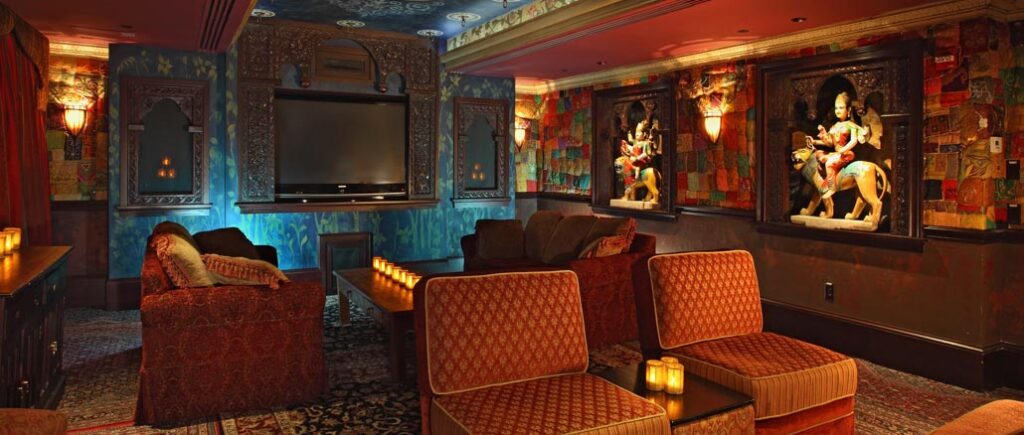
(The Foundation Room at Mandalay Bay. Image source: Networking Vegas)
The Foundation Room is likely delaying the removal of these statues because religious language and iconography are central to the nightclub’s brand identity and marketing strategy. The suits who manage the Foundation Room surely recognize that removing the other icons would be a concession that would lead to an expensive rebranding project. The nightclub’s motto, after all, is “Good Karma Awaits.” Private dining rooms for VIP guests are called “Prayer rooms” — there is a Ganesh-themed prayer room as well as a Buddha-themed prayer room. A promotional photo shows two dancers in shimmery mini-skirts and fringe bras sitting on Lord Mahavira’s lap like he’s a strip mall Santa Claus. A second promotional photo for the Foundation Room shows a dancer in black lace panties and bra doing the splits in front of a statue of Lord Shiva, the Hindu god — her provocative pose a pervy parody of Shiva’s cosmic dance of creation and destruction. The club’s dancers are dubbed “Nightlife Goddesses.” Promotional materials invite you to “Immerse yourself in our DEITY dancer experience.”
Although Eastern religious imagery predominates in casinos and nightclubs, the booming Las Vegas wedding industry caters to those who desire the trappings of a Christian wedding. Off the strip is “Chapel Row,” where thousands of couples elope every year: The Little Vegas Chapel, Graceland Chapel, Chapel of the Flowers, A Little White Wedding Chapel. The chapels are church-y enough (with steeples and pews) to give a wedding the requisite gravitas without being too church-y (no priests asking prying questions).
It’s not just that religious icons and architecture adorn the Strip. The entire economic engine of Las Vegas depends on certain quasi-religious habits of mind: the superstitious rituals of the septuagenarian who will only play slots on a particular blinking Gilligan’s Island machine; the hundreds of Hawaiian pilgrims who travel to rub the belly of the “Happy Buddha” at the California Hotel and Casino; the sports better with his lucky colors and numbers.
For ancient religious peoples, there was no such thing as coincidence; chance was the language of the gods, and so cleromancy (divination by sortition or the drawing of lots) was common practice in ancient cultures everywhere. In Vegas, there’s a similarly religious belief that chance can be pressed into the service of one’s good fortune — that it can be channeled if the proper propitiations are made, and that it communicates something cosmic. Some scholars opine that the Urim & Thummim, that mysterious oracular device in the Hebrew Bible, might actually have been a pair of sacred dice. How very Vegas! As the Proverbs state, “We may throw the dice, but the LORD determines how they fall.”
Another major piston in Vegas’ economic engine is the music industry, which relies on the worshipful devotion of fans for musicians in residency. Camille Paglia has argued that since at least the twentieth century the relationship between the American public and celebrities has been, at root, religious: “The Hollywood studio system. . . projected its manufactured stars as simulacra of the pagan pantheon.” She points out that the word “fans” derives from the Latin fanatici, which originally referred to maddened worshippers of the goddess Cybele. Paglia elaborates: “Outbursts of quasi-religious emotion could be seen in the hysterical response of female fans to Rudolph Valentino, Frank Sinatra, Elvis Presley, and The Beatles. … The rumor that Elvis still lives is still stubbornly planted in the culture, as if he were a demigod who could conquer natural law.” Indeed, Elvis is Las Vegas’ tutelary deity. Dozens of incarnations of the immortal King can be seen strutting and thrusting on Las Vegas streets.
What Las Vegas offers is a theophany: a face-to-face encounter with goddesses Britney, Celine, and Mariah. Many fans were serious when, circa 2016, they rechristened Britney Spears (who performed at Planet Hollywood from 2013-2017) as “Godney” and “The Holy Spear-it.” In light of these devotional nicknames, the title of her Planet Hollywood show takes on a peculiarly eucharistic quality: Piece of Me. A-list celebrities like Britney used to tour the world, and the public’s only access to them was through Paparazzi photos in tabloid magazines and the off chance the tour bus would come to a nearby metropolis. Las Vegas invites us, like Moses invited the 70 elders, to scale Mount Sinai.
There’s also the multi-million dollar magic industry, which banks off the willing credulity of thousands of spectators every year and traffics in an explicit rhetoric of “belief.” Criss Angel, whose name has obvious religious connotations and who often wears a prominent cross on his neck, had a recent show called “Believe.” It was Angel who “walked on water” at a Las Vegas hotel pool. A segment of his more recent show “MindFreak” takes place against the projected backdrop of a crumbling interior of a gothic cathedral, a crucifix prominent at center stage. In one stunt, Criss suspends his body from a helicopter by fish hooks, a feat – being suspended by one’s skin – which has its origins in Native American and Hindu religious traditions.
Like religious mystics, many tourists to Las Vegas are seeking alternative forms of consciousness. While religious mystics use prayer and contemplation, tourists use weed or booze or both. But both mystics and tourists use music and dance. Like a whirling dervish, the bass-and-booze-bathed club-hopper can sometimes achieve a state of disembodied religious ecstasy, with individuality melting into the moshing multitude. Émile Durkheim believed this experience, which he called “collective effervescence,” to be the oldest and most original religious experience.
The famous music festival held each Spring outside of Las Vegas, the Electric Daisy Carnival or “EDC”, the largest electronic dance music festival in North America, seems to have its origin in Pagan spring equinox festivals, the Greek Bacchanal, the Roman Saturnalia, or the Hindu festival of Holi. These are festivals of reversal, in which stifling societal norms are temporarily suspended or inverted. EDC, like its religious predecessors, provides a cathartic release valve for the pent-up tensions of life. These festivals allow one to shirk off the burden and anxiety of individuality and become subsumed into some greater whole. First-time EDC attendees often use a convert’s language to describe their experience. “I will never forget the feeling I felt when I first entered EDC this year; it was a feeling of wholeness,” one person reflects. Some speak of EDC with a distinctly Millenarian hope: “In my opinion, music festivals are the only hope we have left at bringing peace to this world.” EDC is not simply a music festival, but a totalizing ethos summed up in raving culture with the acronym PLUR: peace, love, unity, and respect. In all these ways, the Pentecostal holy roller and the painted raver might be more closely related than either of them would like to admit.
***
Many people forget that people actually live in Las Vegas. But we do. We live in beige suburban homes and shop at chain grocery stores and go to school. And we worship. In synagogues and mosques and temples, we pray and prostrate and meditate.
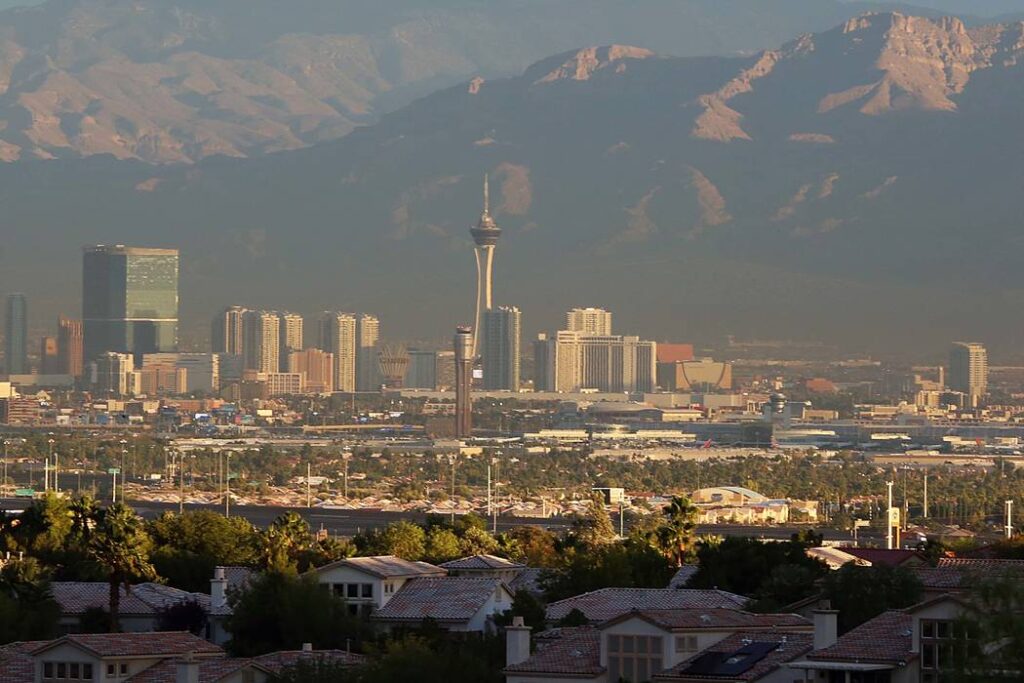
(View of the Strip from a Las Vegas residential neighborhood. Image credit: Bizuayehu Tesfaye)
The Vegas economy depends on the labor of Christian card dealers who are personally opposed to gambling and Muslim taxi cab drivers who ferry customers to strip clubs they themselves would never attend. A Latter-day Saint father I know valets sexy luxury sports cars late at night so he can afford to drive his four kids around in an unsexy mid-size SUV during the day.
Religion in Las Vegas is incredibly diverse. One of the first assignments I give students in my high school Comparative Religions class is to map the religious diversity in our community. Of course there are hundreds of Christian churches in Las Vegas, but did you know there are also three Sikh temples? A Hindu temple and Jain center? Fourteen Jewish synagogues?
This religious diversity is also found in my classroom. There’s Maya, a Black Filipina and Evangelical Christian, who before attending my school attended a private Christian school, where (as she tells it) she learned to fear everything different as demonic: Pokémon, yoga, meditation. There is Katie, a Mexican freshman. Her family are devout Christians, but she considers herself “spiritual.” Her beliefs are a syncretic hodgepodge of Eastern religions and New Age spirituality. She is a discerning curator of the best TikToks related to religion and spirituality, and she will send me all of her best finds.
My student Karen came to the United States two years ago from Cuba. I’ve made friends with Karen’s family, and her mom invited my family to their home to share a meal. They regaled us with stories of the Yoruba pantheon as we ate mounds of papa rellena. A debate broke out between family members about whether all of the orishas are merely manifestations of the one high God Olodumare, or whether the orishas had a real and separate existence on their own. Karen’s mom made offerings of candy and cake to a representation of the orisha Eleguá that she keeps in her living room. I asked Karen to tell me some of the stories about their traditions, but she didn’t know them well enough to tell them to me. She would start, falter, and then ask her Mom to jump in and tell the story for her.
Carlos is agnostic. He’s convinced the great prophets and mystics were all “high off ‘shrooms or something.” Carlos is a novelist, and though he doesn’t believe in Christianity, he takes artistic inspiration from the Bible and Paradise Lost. Derrick, a Black musician with Beats headphones perched on top of his afro, believed in God until his mother died from cancer when he was nine; now, he’s not so sure. Daniela “failed” her Catholic communion “test” because she was busy working the night shift at Taco Bell, didn’t have time to memorize the Nicene Creed, and doesn’t believe any of it besides. Laura believes in the healing properties of energy crystals. Lizbeth goes to her grandma for limpias (spiritual cleansings) with sage; her grandma can discern if you have a negative presence in you by cracking an egg over your head and reading the color of the yolk inside.
Some of my students are creed-believing Christians. Jeremy, a spectacled Filipino and aspiring video game designer, is a well-informed and Biblically literate Seventh Day Adventist. But many students’ religious beliefs are more heterodox and syncretic. They believe or practice some things taught to them by their parents, and reject others. (They often reject their parents’ religions without knowing much at all about what it is they’re rejecting.) They may call themselves Catholic, but dabble in New Age spiritualism, use healing crystals, flirt with reincarnation, and talk about chakras. Almost all have firsthand ghost stories or stories about bruhas (witches). In a discussion about Macbeth in my English class, I asked if anyone had had experiences with ghosts. I was shocked at the number of students who claimed to have personally witnessed something paranormal, and the earnestness with which these stories were told. The most forthcoming storytellers were often the students who were most adamantly “secular” and irreligious.
My students are atheists who know their Zodiac signs and faithfully read the horoscopes. They are agnostics who swear by platitudes like, “Everything happens for a reason.” Very few of my students regularly attend church services. For these reasons, classifying my students into religious affiliations or denominations feels reductive.
The fact that my students live in Las Vegas is not incidental to their amorphous religious identities. They live, after all, in a city famous for a surfeit of choices— a city of buffets. The term “Cafeteria Catholic” is used disparagingly (usually by other, gate-keeping Catholics) to refer to those who “pick and choose” which doctrines and practices of the Church they want to believe and abide by. My students are unashamed “Buffet Believers,” and have no qualms about sampling entrées from many religious traditions, with little concern about coherence or contradiction.
The diversity in a tourist city like Las Vegas also impacts my students’ religious outlook. As my student Ximena puts it, “I personally view my religion as a big part of myself and my life, but I’m still able to connect with people of different religions or people who are not religious because Vegas’s diversity has allowed me to learn that people don’t have to be religious or the same religion as you in order for them to be good people.”
Nevada is a “purple” state and Las Vegas a hotbed of political contest and controversy. Many of my students have felt the need to create their own religious identities after feeling abandoned by a Christianity they see as too partisan and too closely allied to Republican politics and conservative social issues.
Las Vegas is also a town of transplants. Many of my students’ families immigrated to Las Vegas from Mexico. Because religious identity is frequently linked to particular locations, and is nourished in the young by the old, my students’ separation from their extended families in Mexico has had a formative impact, estranging them to one degree or another from the religions of their grandparents.
One student speculates that her turn away from Catholicism is related to her parents’ immigration to the United States. In Mexico, she explains, her family is very poor, and their poverty impels them to rely on God. When her father first immigrated to the United States, his economic uncertainty caused him to pray regularly and to teach his daughters to pray. As their economic situation improved, however, the frequency of prayer and God-talk diminished.
But my students are not entirely unique; the landscape of religious belief is changing for Gen Z as a whole. As of 2018, only 33% of Gen Z had “no doubts” about the existence of God. This is significantly lower than the Silent Generation (70%), Baby Boomers (59%), Gen X (52%), and even Millennials (44%). But it would be a mistake to read this data as a straightforward proof of steady generational secularization. My experience with my students leads me to believe that something more complicated is happening. Students aren’t becoming more secular; instead, they are swapping orthodox religious beliefs and practices for a somewhat haphazard spiritual potpourri.
Psychologist Clay Routledge has coined the term “religious substitution” to describe the phenomenon I am witnessing with my students. “Fewer people today may be identifying as religious and attending religious services, but there is scant evidence that they are abandoning spiritual pursuits and supernatural beliefs altogether,” he writes. “It would be more accurate to describe many current trends as evidence not of secularization, but of religious substitution.” So, belief in God and religious participation are declining, but three quarters of Americans believe in the paranormal: ghosts, witchcraft, astrology, telepathy, clairvoyance, et cetera. And it is those who are least engaged in traditional religious practices (like regular church attendance) who are most likely to have paranormal beliefs.
My students’ religious identities are irreducibly multiple. Westerners aren’t typically accustomed to thinking of religious identity as multiple, but this is more common elsewhere. It has been said that the Chinese are Confucians at work, Daoists at play, and Buddhists at death. Or, according to a popular saying, “Every Chinese person wears a Confucian cap, a Daoist robe, and Buddhist sandals.” It may be that this multiplicity is the future of American religion. Indeed, if my students’ experiences may be read like tea leaves in a diviner’s cup, that future may be now.
To some, this may be an exciting picture: free-for-all spirituality, freed from the crushing conformity of creeds, can better serve the needs of the individual. Others might object that this grab bag style of spirituality provides no local community and makes no demands on the individual. What are the consequences if religion becomes so individual and idiosyncratic?
***
Perhaps it is not so surprising that the supposedly secular Las Vegas is profoundly religious in many ways: the great monotheisms were all born and nurtured in the desert, and many have postulated that desert ecosystems are especially hospitable for religious ways of thinking.
The Hebrews wandered for 40 years in the desert before God’s revelation at Sinai. Christianity was honed and refined by 3rd Century “Desert Fathers” who exiled themselves to the Egyptian desert for contemplation and prayer. “He who wishes to live in solitude in the desert is delivered from three conflicts: hearing, speech, and sight,” wrote Anthony the Great. “There is only one conflict for him and that is with fornication.” (Anthony would certainly find the Mojave Desert even less conducive to chastity than the Egyptian deserts.)
Indeed, there is something about the precarity of life in the desert, its unforgiving infertility, that fertilizes religious thinking. “The desert resembles dogma: it is dry, it is immovable,” as Richard Rodriguez once wrote in Harper’s.
Indeed, something about the miracle of a metropolis in the Mojave suggests, at once, both the exceptionality of human beings and their sinful hubris. (The Hoover Dam is proof of human exceptionalism; the rapidly drying Lake Mead, which provides Las Vegas with 90% of its water, is damning proof of human hubris.) To live in the desert is to experience a haunting sense of (spiritual) dislocation. Rodriguez, again: “The desert’s uninhabitability convinces Jew and Christian and Muslim that we are meant for another place.” Eden and Heaven are oases; the desert is the crucible of the soul.
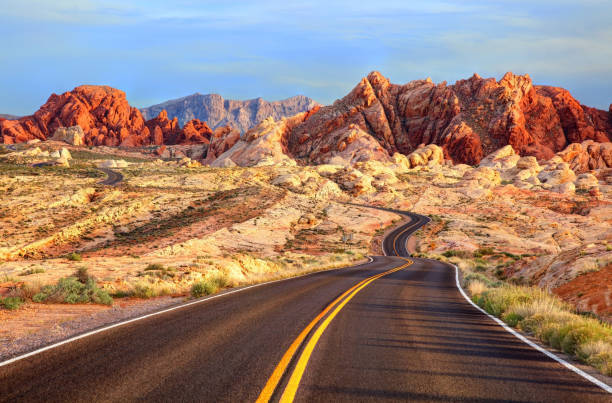
(Mojave Desert. Image source: iStock)
But while Middle Eastern deserts birthed the monotheisms, the Mojave Desert has birthed a hydra of heterodoxies. My students, like many in their generational cohort, are straining against the practices and creeds that they’ve inherited. They like their religion a la carte and are unafraid to combine elements of traditional faith with tarot card reading, crystals, and divination. Some wonder: What chimera, what bastardized Franken-religion, are they creating in the process?
Was Yeats writing of my Mojave when he wrote of a monstrous new revelation rising up in the sands of the desert?
“Surely some revelation is at hand;
Surely the Second Coming is at hand.
The Second Coming! Hardly are those words out
When a vast image out of Spiritus Mundi
Troubles my sight: somewhere in sands of the desert
A shape with lion body and the head of a man,
A gaze blank and pitiless as the sun,
Is moving its slow thighs, while all about it
Reel shadows of the indignant desert birds.
The darkness drops again; but now I know
That twenty centuries of stony sleep
Were vexed to nightmare by a rocking cradle,
And what rough beast, its hour come round at last,
Slouches towards Bethlehem to be born?”
And yet, what is orthodoxy except heterodoxy that has been sanctified by time? Perhaps it is better to describe my students, as one researcher has done, as “spiritual explorers.” Or, it might be even better to describe them as religious reformers— as Luthers of a new Protestantism. And what are they protesting? Ask them, and they will tell you. Their grievances are many, but because they are unafraid to borrow from the wisdom of many traditions, their resources are bountiful.
My students will tell you that they are attracted to Buddhism because they have seen firsthand how greedy and grasping casinos exploit their mothers and aunts who work in the hotels as maids. They will tell you that they find Confucius’s emphasis on education inspiring because they know Nevada public schools perform abysmally. They will share their enthusiasm for the powerful female deities of Hinduism because in Las Vegas women and girls are so often objectified and treated as sexual commodities. They celebrate Daoism’s respect for nature because they are only too aware of how climate change and drought affect their city.
There will be no creeds or catechism in this new Protestantism. Instead, this new religion will make flexibility its watchword: it will encourage the shameless borrowing of concepts, rituals, beliefs, and ideas from any and all traditions. And this time, the Reformation starts not at Wittenberg, but in Sin City.
Corey Landon Wozniak lives with his wife and three sons in Las Vegas, NV. He teaches English and Comparative Religions at a public high school.